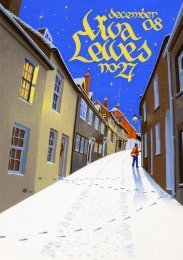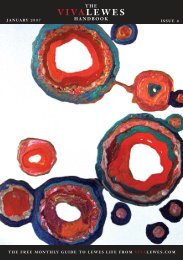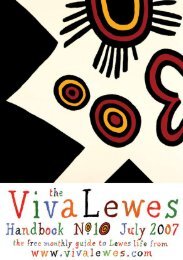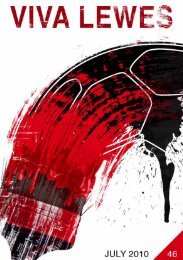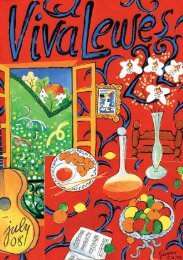Call us now on: 0800 731 5905 - Viva Lewes
Call us now on: 0800 731 5905 - Viva Lewes
Call us now on: 0800 731 5905 - Viva Lewes
Create successful ePaper yourself
Turn your PDF publications into a flip-book with our unique Google optimized e-Paper software.
MYLEWES JuLia RuShbuRY<br />
Julia R<str<strong>on</strong>g>us</str<strong>on</strong>g>hbury is a mural painter who has lived in<br />
<strong>Lewes</strong> for over fifty years. Her father was Sir Henry<br />
R<str<strong>on</strong>g>us</str<strong>on</strong>g>hbury, an artist who gained internati<strong>on</strong>al re<str<strong>on</strong>g>now</str<strong>on</strong>g>n<br />
as <strong>on</strong>e of the leaders of the British etching revival in<br />
the 1920s. An ack<str<strong>on</strong>g>now</str<strong>on</strong>g>ledged master of topographical<br />
drawing, he also served as an official war artist in both<br />
world wars. In the latter part of his life he was a distinguished<br />
Keeper of the Royal Academy, improving<br />
the RA schools bey<strong>on</strong>d recogniti<strong>on</strong>. For many years his<br />
work was neglected except by a small body of collectors.<br />
The 1989 exhibiti<strong>on</strong> at Birmingham City M<str<strong>on</strong>g>us</str<strong>on</strong>g>eum and<br />
Art Gallery, marking the centenary of his birth, and a<br />
small show this summer in the Tennant Gallery at the<br />
Royal Academy, running until 12th Sept, have brought<br />
a new generati<strong>on</strong> to look at his work afresh. To coincide<br />
with the exhibiti<strong>on</strong>, a Catalogue Rais<strong>on</strong>né of his prints<br />
has been published.<br />
What was your father’s c<strong>on</strong>necti<strong>on</strong> with <strong>Lewes</strong>? In<br />
his early days he had rented cottages in West S<str<strong>on</strong>g>us</str<strong>on</strong>g>sex at<br />
Bosham and Amberley, but he always liked the country<br />
around <strong>Lewes</strong> and my parents moved here in 1957.<br />
What was <strong>Lewes</strong> like in those days? A small market<br />
town, still stifled by the rigid social hierarchy that<br />
comes across so clearly in Mrs Dudeney’s Diary. I’m<br />
afraid my father found it all rather dull, missing the<br />
c<strong>on</strong>genial company of fellow artists at the RA and the<br />
Chelsea Arts Club. He didn’t go out much, and was given<br />
to indicating that the visits of neighbours had g<strong>on</strong>e<br />
<strong>on</strong> too l<strong>on</strong>g by going round the room plumping up the<br />
c<str<strong>on</strong>g>us</str<strong>on</strong>g>hi<strong>on</strong>s. But he relished the company of his numero<str<strong>on</strong>g>us</str<strong>on</strong>g><br />
grandchildren, and greatly enjoyed the visits of former<br />
pupils and old artist friends like Ethelbert White and<br />
Photo by Emma Chaplin<br />
Percy Hort<strong>on</strong>.<br />
What did your parents like about <strong>Lewes</strong>? They<br />
loved their ho<str<strong>on</strong>g>us</str<strong>on</strong>g>e, 6 St Martin’s Lane, with its balc<strong>on</strong>y<br />
overlooking the valley and the Downs. When they<br />
bought it, the ho<str<strong>on</strong>g>us</str<strong>on</strong>g>e was d<strong>on</strong>e up by Wicks, a local<br />
building firm. At the time, Dennis Wicks, a re<str<strong>on</strong>g>now</str<strong>on</strong>g>ned<br />
opera singer who had begun his career as a bass in the<br />
Glyndebourne Chor<str<strong>on</strong>g>us</str<strong>on</strong>g>, sometimes helped the family<br />
firm out if they were eager to finish a job <strong>on</strong> time.<br />
My mother, unaware of the m<str<strong>on</strong>g>us</str<strong>on</strong>g>ical c<strong>on</strong>necti<strong>on</strong>, <strong>on</strong>ce<br />
exclaimed to me, “What a w<strong>on</strong>derful town <strong>Lewes</strong> is!<br />
Even the carpenters are able to sing Mozart arias while<br />
they work”.<br />
Tell <str<strong>on</strong>g>us</str<strong>on</strong>g> about a cherished <strong>Lewes</strong> landmark. The<br />
cycle rack in Grange Gardens, erected by the Friends<br />
of <strong>Lewes</strong> to commemorate Elisabeth Howard. She was<br />
an indefatigable c<strong>on</strong>servati<strong>on</strong> campaigner, often to be<br />
seen riding around <strong>Lewes</strong> <strong>on</strong> her heavily encumbered<br />
bicycle. I was at Langford Grove School with her, in<br />
Barcombe Mills. In 1946, I and five other girls, all going<br />
<strong>on</strong>to Art School, were put up at Westgate Ho<str<strong>on</strong>g>us</str<strong>on</strong>g>e<br />
whilst learning how to <str<strong>on</strong>g>us</str<strong>on</strong>g>e the lithographic press<br />
owned by the Ladies of Miller’s.<br />
What do you dislike about <strong>Lewes</strong>? The ever-increasing<br />
volume of traffic <strong>on</strong> Southover High Street. Useless<br />
traffic-calming measures. The smug hypocrisy of<br />
those who bang <strong>on</strong> about the envir<strong>on</strong>ment while fitting<br />
in as many short haul holiday flights to Naples or Bratislava<br />
as they can.<br />
Recommend a film. Fellini’s La Strada, a poignant<br />
and beautiful work that I never tire of.<br />
David Jarman<br />
1 5




